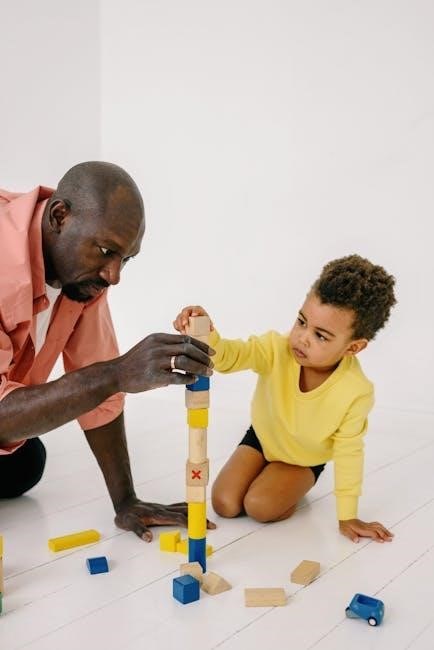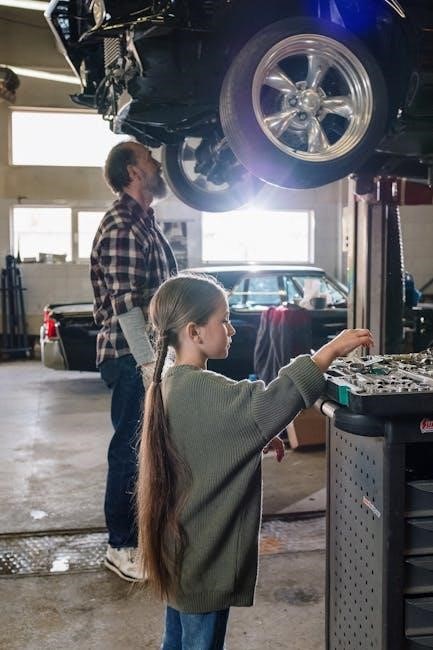
Addiction profoundly impacts family dynamics, creating complex roles and patterns that affect every member. Understanding these roles is crucial for addressing the collective trauma and fostering recovery.
1.1; Defining Family and Its Importance in Society
Family is a fundamental social unit, typically defined as a group of individuals related by blood, marriage, or adoption, who share emotional bonds, responsibilities, and a common life. Families play a vital role in shaping individual identities, providing emotional support, and fostering societal stability. They serve as the foundation for teaching values, norms, and cultural practices, influencing how individuals interact with the world. Beyond biology, family can also include chosen relationships, highlighting its adaptability and universal significance. The structure and dynamics of families vary widely, but their importance in human development and societal functioning remains consistent across cultures and time.
1.2. Understanding Addiction as a Family Disease
Addiction is often described as a family disease, as it profoundly impacts not just the individual struggling with substance use but also their entire family system. The dynamics within the family are altered, creating a ripple effect of emotional, psychological, and behavioral changes. Family members may unintentionally enable the addiction through financial or emotional support, while others may adopt roles like the caretaker or scapegoat to cope with the stress. This interconnectedness highlights how addiction is not an isolated issue but a collective challenge requiring a family-centered approach to healing and recovery.
1.3. The Impact of Addiction on Family Dynamics

Addiction disrupts family dynamics, creating a chaotic and emotionally charged environment. Family members often develop unhealthy coping mechanisms, such as enabling or codependency, to manage the stress caused by the addict’s behavior. This can lead to emotional trauma, strained relationships, and a breakdown in communication. Roles within the family may shift, with some members taking on excessive responsibilities while others withdraw. The addict’s unpredictable behavior often becomes the central focus, causing the family system to revolve around their needs; This imbalance can result in long-term emotional and psychological distress for all involved, perpetuating a cycle of dysfunction.

Common Family Roles in Addiction
Addiction creates distinct family roles, such as the addict, enabler, caretaker, scapegoat, hero, mascot, and lost child, each coping uniquely to maintain the family’s dysfunctional balance.
2.1. The Addict: The Central Figure in the Family System
The addict often becomes the central figure in the family, with their behavior dictating the family’s dynamics. Their addiction creates a power imbalance, where other members adapt their roles to accommodate the addict’s needs. This can lead to enabling behaviors, emotional strain, and a distorted sense of normalcy. The family may revolve around the addict’s actions, causing other members to lose their own identities and priorities. This central role perpetuates a cycle of dependency, making it challenging for the family to function healthily without addressing the addict’s behavior and its broader impact on the family system.
2.2. The Enabler: Unintentional Support of Addictive Behavior
The enabler often unintentionally supports the addict’s behavior by providing financial, emotional, or logistical assistance. This role stems from a desire to help but ultimately prevents the addict from facing consequences. Enablers may deny the severity of the addiction, cover up for the addict’s mistakes, or rescue them from crises. While their actions are well-meaning, they perpetuate the cycle of addiction and create codependency. Over time, the enabler’s behavior can lead to emotional exhaustion and strain on the family system, making it harder for the addict to seek help and for the family to heal.
2.3. The Caretaker: The Martyr of the Family
The caretaker, often seen as the martyr, takes on the role of self-sacrifice, prioritizing others’ needs above their own. They frequently enable the addict by covering up for their behavior and managing family responsibilities. This role is driven by a deep-seated need to maintain control and balance in the family. Over time, caretakers may feel overwhelmed, leading to emotional and physical exhaustion. Their martyrdom can create resentment and hinder the addict’s recovery, as they inadvertently perpetuate the cycle of addiction while neglecting their own well-being and emotional health.
2.4. The Scapegoat: Diverting Attention from the Addict
The scapegoat assumes the role of diverting attention away from the addict by acting out or creating distractions. This individual often engages in rebellious or problematic behavior, drawing focus to themselves. The family may unconsciously use the scapegoat to avoid addressing the addict’s issues, shifting blame and accountability. This dynamic allows the addict to remain central while the scapegoat bears the brunt of familial frustration. Over time, this role can lead to emotional strain and resentment for the scapegoat, who may feel unfairly targeted while the addiction continues unchecked.
2.5. The Hero: Masking Family Pain with Achievement
The hero emerges as a high achiever, using success to mask the emotional pain caused by addiction. This role often involves excelling in school, sports, or work to distract from the family’s struggles. The hero gains a sense of control and worth through accomplishments, compensating for feelings of helplessness. While appearing strong, the hero may internalize stress, leading to emotional suppression. This role unintentionally supports the addict by maintaining a facade of normalcy, preventing the family from addressing the underlying issues. Over time, the hero may feel overwhelmed by the pressure to perform and the burden of hiding family secrets.
2.6. The Mascot: Using Humor to Avoid Conflict
The mascot uses humor to deflect tension and avoid confrontation, often hiding the family’s pain. By keeping the atmosphere light, they prevent discussions about the addict’s behavior. This role distracts from underlying issues, offering temporary relief but hindering resolution. The mascot may feel pressured to constantly entertain, suppressing their own emotions. While their intent is to maintain peace, it inadvertently supports the addict by avoiding accountability. Over time, this pattern can lead to emotional distancing and resentment, as the mascot’s humor becomes a barrier to addressing the family’s deeper struggles and promoting meaningful change.
2.7. The Lost Child: Withdrawing from Family Interaction
The lost child copes with family turmoil by withdrawing emotionally and socially, often isolating themselves from others. This role emerges as a way to avoid conflict and emotional pain, creating a sense of detachment. The lost child may feel invisible or unimportant, leading to feelings of loneliness and low self-esteem. By disconnecting, they attempt to shield themselves from the chaos caused by addiction. However, this isolation prevents them from expressing their needs or receiving support, further straining family relationships and hindering collective healing. Over time, this pattern can perpetuate emotional distance and hinder personal growth.

How Families Organize Around Addiction
Families often reorganize their dynamics to accommodate addiction, creating roles and rules that inadvertently support the disorder. This restructuring can lead to codependency and dysfunctional communication patterns.
3.1. Enabling Behaviors: Financial and Emotional Support
Enabling behaviors often involve financial or emotional support that unintentionally perpetuates addiction. Family members may provide money for substances, pay bills, or bail the addict out of legal trouble. These actions, though well-intentioned, prevent the addict from facing consequences, delaying recovery. Emotional enabling includes making excuses, denying the problem, or shielding the addict from criticism. Over time, this fosters dependency and codependency, creating a cycle where the family inadvertently supports the addiction. Recognizing and addressing these behaviors is crucial for breaking the cycle and encouraging healthier dynamics.
3.2. Codependency: Unhealthy Patterns of Interdependence
Codependency refers to unhealthy patterns of interdependence where family members become emotionally and psychologically entangled with the addict’s behavior. This dynamic often develops as a way to cope with the stress and unpredictability of addiction. Family members may sacrifice their own needs, enabling the addict’s habits while seeking a sense of control or purpose. Over time, codependency fosters low self-esteem, resentment, and a loss of personal boundaries. Breaking these patterns is essential for recovery, requiring family members to address their own emotional needs and develop healthier ways of supporting the addict without perpetuating the cycle of addiction.
3.3. Dysfunctional Communication Patterns
Dysfunctional communication patterns often emerge in families affected by addiction, fostering an environment of secrecy, denial, and emotional suppression. Family members may avoid discussing the addiction to prevent conflict, leading to passive-aggressive behaviors or miscommunication. These patterns can enable the addict’s behavior by avoiding accountability and reinforcing feelings of shame or guilt. Over time, this distorted communication erodes trust and intimacy, making it difficult for the family to address the addiction openly. Recognizing and addressing these unhealthy communication styles is critical for breaking the cycle of addiction and promoting healing within the family system.

The Effects of Addiction on Family Members
Addiction causes emotional trauma, financial strain, and physical health issues for family members. It disrupts relationships, creates stress, and often leads to long-term psychological distress.
4.1. Emotional Trauma and Stress
Addiction inflicts profound emotional trauma on family members, often leading to anxiety, depression, and feelings of helplessness. The unpredictable behavior of the addict creates a stressful environment, fostering resentment and guilt. Family members may develop codependent patterns, enabling the addiction while neglecting their own emotional well-being. This emotional strain can disrupt relationships and perpetuate cycles of dysfunction. The constant need to cope with the addict’s actions often results in emotional exhaustion, making it challenging for families to maintain healthy communication and support systems. Addressing these emotional wounds is essential for breaking the cycle of addiction and fostering recovery.
4.2. Physical Health Consequences
Addiction’s impact extends beyond emotional harm, causing significant physical health consequences for family members. Chronic stress from living with an addict can lead to anxiety-related illnesses, compromised immune systems, and sleep disturbances. Caregivers often neglect their own health, leading to exhaustion and heightened susceptibility to illness. Prolonged exposure to a stressful environment can result in long-term conditions like hypertension or diabetes. Additionally, family members may experience secondary health issues due to the addict’s unstable behavior or poor lifestyle choices, further exacerbating the physical toll of addiction on the entire family system.
4.3. Financial Burden and Instability
Addiction often places a significant financial strain on families, as they may cover expenses related to the addict’s habits, legal issues, or medical emergencies. Family members frequently enable the addiction by providing financial support, inadvertently perpetuating the cycle. This can lead to debt, depleted savings, and instability in household budgets. Additionally, neglecting financial responsibilities to support the addict can result in long-term economic challenges. The financial burden not only affects the family’s stability but also contributes to emotional stress, creating a vicious cycle of dependency and hardship that extends beyond the addiction itself.

The Role of Family in Recovery

Families play a crucial role in recovery by providing emotional support, fostering a healthy environment, and participating in therapy to address addiction’s impact on relationships.
5.1. Importance of Family Therapy in Addiction Recovery
Family therapy is essential in addiction recovery, as it addresses the complex dynamics and emotional trauma within the family system. It provides a structured environment for open communication, helping members understand the addiction’s impact and their roles in it. By fostering empathy and accountability, therapy encourages collaboration between the family and the individual in recovery. This collective approach promotes healing, rebuilds trust, and strengthens relationships. Family therapy also equips members with tools to break unhealthy patterns, supporting long-term recovery and preventing relapse. It aligns everyone toward shared recovery goals, creating a supportive network for sustained healing and healthier family interactions.
5.2. Breaking Unhealthy Patterns and Fostering Support
Breaking unhealthy patterns requires families to confront and redefine their roles in addiction. Education on codependency and enabling behaviors is crucial, helping members recognize how their actions may unintentionally support addiction. Setting boundaries and encouraging open communication fosters a supportive environment, allowing family members to express emotions and needs honestly. Mutual support systems, such as therapy or support groups, empower families to heal collectively. By addressing dysfunctional dynamics and promoting accountability, families can shift from enabling to encouraging recovery. This transformation creates a foundation for lasting change, enabling the addict and their loved ones to rebuild trust and work toward a healthier future together.

Family Dynamics and Addiction
Family dynamics often create enabling environments for addiction, fostering unhealthy patterns that unintentionally support addictive behaviors and perpetuate emotional distress among all members.
6.1. Shame and Guilt in the Family System
Shame and guilt are central emotions in families affected by addiction, often leading to emotional turmoil and dysfunctional patterns. Family members may feel responsible for the addict’s behavior, fostering a cycle of self-blame. Shame can silence individuals, preventing open communication about the addiction. Guilt may drive enabling behaviors, as loved ones attempt to compensate for the addict’s actions. These emotions create a toxic environment, reinforcing unhealthy roles and hindering recovery efforts. Addressing shame and guilt is essential to break the cycle of addiction and promote healing within the family system.
6.2. Boundaries and Their Impact on Addiction
Boundaries play a critical role in the family system, influencing how addiction evolves and is managed. Clear boundaries help protect family members from the addict’s harmful behaviors, fostering accountability and recovery. However, when boundaries are unclear or overly rigid, they can enable addiction by allowing destructive patterns to persist. Healthy boundaries encourage responsibility and independence, while unhealthy ones can perpetuate codependency. Establishing and maintaining appropriate limits is essential for breaking cycles of addiction and promoting emotional and physical well-being within the family. Balancing protection and support is key to creating an environment conducive to healing and long-term recovery.
6.3. Rituals and Their Role in Family Addiction Dynamics
Rituals within families affected by addiction often serve as coping mechanisms, providing a sense of structure and normalcy. These rituals can either support or hinder recovery. For instance, families may develop patterns like avoiding discussions about the addiction during meals or gatherings, which can perpetuate denial; Conversely, healthy rituals, such as attending therapy sessions or support groups together, can foster healing and communication. Rituals reflect the family’s values and dynamics, influencing how they address or avoid the addiction. Recognizing and transforming harmful rituals is essential for breaking cycles of addiction and fostering a supportive environment for recovery and growth.
Long-Term Effects of Addiction on Family Roles
Addiction reshapes family roles, causing lasting emotional and relational strain. Roles often pass through generations, perpetuating cycles of dysfunction and increasing vulnerability to addiction.
7.1. Intergenerational Trauma and Addiction
Intergenerational trauma significantly influences addiction patterns within families; Unresolved emotional wounds and dysfunctional behaviors are passed down through generations, creating cycles of abuse and dependency. Family roles often become rigid, with members unconsciously adopting behaviors that perpetuate addiction. This transmission can occur through genetic predisposition, learned coping mechanisms, or environmental factors. Breaking these cycles requires acknowledging the past and actively engaging in therapeutic interventions. Understanding intergenerational trauma is crucial for fostering healthier family dynamics and preventing future generations from repeating harmful patterns. Addressing these deep-seated issues promotes long-term recovery and resilience within the family system.
7.2. The Role of Genetic Factors in Addiction Susceptibility
Genetic factors play a significant role in addiction susceptibility, with hereditary influences accounting for 50-75% of the risk. Specific DNA variations can alter brain chemistry and neurotransmitter function, making some individuals more prone to addictive behaviors. While genetics don’t predetermine addiction, they increase vulnerability. Environmental and psychological factors also contribute to the development of addiction. Recognizing the genetic component is crucial for understanding susceptibility and tailoring interventions. This awareness helps in creating personalized treatment plans that address both biological and environmental aspects, potentially breaking intergenerational cycles of addiction within families.

Rebuilding Family Roles in Recovery
Rebuilding family roles in recovery involves redefining responsibilities and fostering a supportive environment, helping members break unhealthy patterns and establish healthier dynamics for lasting change.
8.1. Redefining Roles for a Healthier Family Dynamic

Redefining roles in recovery involves shifting from enabling or caretaking behaviors to balanced, supportive interactions. Family members must recognize and change unhealthy patterns, fostering open communication and mutual respect. This process encourages each individual to take responsibility for their own well-being, reducing codependency and promoting emotional healing. Therapy and education play key roles in helping families redefine their dynamics, creating a foundation for long-term recovery and resilience.
8.2. Strengthening Family Relationships Post-Recovery
Rebuilding family relationships after recovery requires open communication, empathy, and a commitment to change. Setting healthy boundaries and fostering mutual respect are essential for creating a supportive environment. Families can engage in shared activities and celebrate milestones to rebuild trust and connection. Professional guidance, such as therapy or support groups, can provide tools to navigate challenges and sustain progress. By prioritizing emotional well-being and accountability, families can strengthen their relationships and create a foundation for lasting healing and growth.
